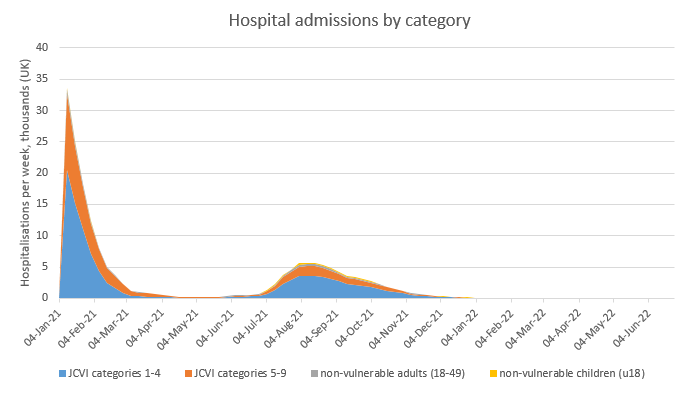
Big cause to celebrate in my deviation graphs this evening: over-80s cases have fallen to *half* their January rate, over and above the effects of lockdown on all age groups. I think we can say confidently that vaccines have been the major driver of that additional fall. 1/10 

Another way of looking at this: in the second half of January, before vaccination effects started to bite, over-80s consistently accounted for 5.8% of total covid cases. In the 7 days to 12th March, they averaged 2.9% i.e. half their previous value. 2/10
As regular readers will know, there are reasons to believe that the actual vaccine effect could be larger than that 50% fall e.g. due to higher-risk behaviour by those who have been vaccinated, and due to the weaker impact of lockdown on cases in the over-80s. 3/10
But even if it’s only a 50% effect from the first dose (so far), that’s still a good start and many lives saved. Just to note that I calculated the effect in two different ways, one using the over-80s case numbers as a % of the total cases, and another using the … 4/10
… over-80s compared to the 20-49 year olds - just in case the movements in other vaccinated age groups, or in school-age children, were causing distortions. Helpfully, I get exactly the same result from both methods. 5/10 

Looking at the subgroups within the over-80s, we can see that the over-90s are already below 45%, with the 80-89s hovering a bit above 50% 6/10 

And in the 70-somethings, we see that the 75-79s are also nearing the 50% mark (actually at 50.4%), and the 70-74s still around 60%. So, with the help of a bit of rounding, we can extend our headline to say that the 75+ cases have also halved, in relative terms. 7/10 

In the 60-somethings, both groups continue their downward trend, although with some way still to go. 8/10 

And we can see the start of a deviation in the 50s as well. This is a bit too early to be the effect of JCVI cohorts 8 & 9 (50-54 & 55-59) who are being vaxxed now – instead I think it’s cohort 6 (the “at risk” or “vulnerable” group) which contains a lot of 50-somethings. 9/10 

So that’s all good news as far as I can see. I’m just going to indulge myself by posting these curves again, and letting it sink in. Without vaccines, probably at least twice as many 75+ year olds would be catching covid as are doing so right now. /end 

• • •
Missing some Tweet in this thread? You can try to
force a refresh











